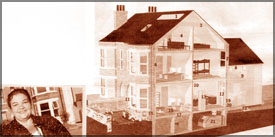|
observer |
|
|
|
|
|
OTHER LINKS |

|

|

|
|
|
 |
than is produced by the average car. When Ms Poyzer and her husband Gil Schalom bought their home eight years ago, they were determined to prove that even a draughty (letting in air) pile built more than a century ago could be transformed into a model for eco-efficiency.
After a 60,000 Sterling Pounds refit, the house's toilets flush with rainwater, the kitchen was built from yoghurt pots, and the walls are insulated with newspapers. Even the doorbell has its own solar panel.
In a typical home, 20 per cent of all heat lost is through leaky windows, but Ms Poyzer installed triple glazing and gave her home a "duvet" of polystyrene cladding.
Walls and floors were insulated with old newspapers and wool. Lighting is provided by hyper-efficient LED bulbs, similar to those recently installed at 10 Downing Street (the British Prime Minister's residence).
Showers are heated by solar panels when it's sunny, while a wood-burning boiler kicks in on cloudy days.
Since May, the Government has pledged 4.2 m Sterling Pounds to help homeowners install wind turbines, solar panels and other "micro-generation" technologies. Dave Timms, from Friends of the Earth, said: "Everyone wants to help tackle climate change, but many people can't even afford basic energy-saving measures such as loft insulation, let alone solar panels.
The Government must get stuck in by taxing polluting activities, and giving tax breaks and grants to help us all go green".
The Independent on Sunday









